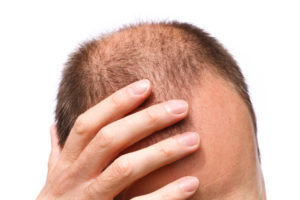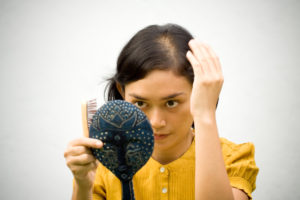

The cause of hair loss lies within the hair follicle, a microscopic pocket in the skin.
Hair sprouts from this pocket, journeying through four distinct seasons — growth, regression, rest and shedding. In the growth phase, the hair shaft lengthens. Then the follicle begins to shrink; this is the regression phase. Next comes the rest phase. The remains of the follicle hang on to the dead hair. Finally, it sheds the old hair in preparation for growing a new one. Hairs on the scalp may stay in the growth phase for years before moving through regression, rest and shedding, which is why hairs can grow so long.
Hair grows, then rests, then falls out. Each hair follicle on your scalp produces a number of hairs throughout your life. Hair grows from the follicle at the rate of about 1cm a month for about three years. After that time that hair will die and no longer grow and simply sit dormant in the follicle for a further three months. After that three month interval the next hair starts to grow out of the follicle and, as it grows, it pushes the original one out. This is a cycle that continues throughout life.
Androgenetic alopecia
Androgenetic alopecia is a common form of hair loss affecting both men and women equally. In men, this condition is known as male pattern baldness (MPB) while in female it is female pattern baldness (FPB) or female pattern hair loss (FPHL).
In male baldness the hair loss follows a well-defined pattern. It begins above both temples and then gradually the frontal hairline recedes to form a characteristic “M” shape. Also the hair thins at the crown (near the top of the head), often progressing to partial or complete baldness. Usually the back and sides of the head remain unaffected, but for a few men with severe pattern baldness, they can experience some thinning in these areas.
The presentation of female pattern baldness is usually quite different from men. In women, the hair becomes thinner all over the top of head, to give a diffused hair loss but the frontal hairline does not usually recede. Baldness of the female pattern rarely leads to overall hair shedding of the scalp. Also, the mechanism of female pattern baldness is slightly different from that of men. Although pattern baldness is a common hair loss cause in both genders, it is more evident in men than in women. A survey result shows that this form of hair loss affected about 35 million men in the United States. Male or female baldness can start as early as in the teenage years of a person and the risk increases with age. More than 50 percent of men that are in the age-group of above 50 have some degree of pattern baldness. In women, the female pattern baldness is most likely to begin after menopause.
Our Success Rate

